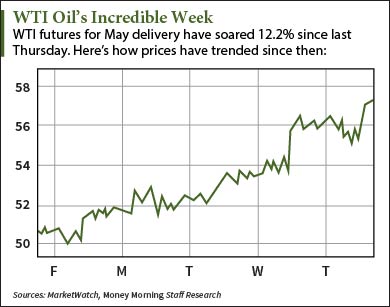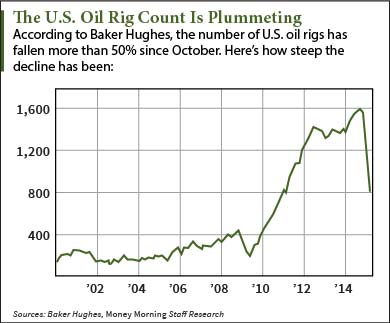 WTI crude oil prices climbed to $56 per barrel this week for the first time in 2015. At this week's high, crude is now up 28% from its early-March low of $44.03.
WTI crude oil prices climbed to $56 per barrel this week for the first time in 2015. At this week's high, crude is now up 28% from its early-March low of $44.03.
Now many investors who want to play the oil price rebound are investing in an oil index ETF.
One of the most popular crude oil ETFs has been the United States Oil Fund LP (NYSE: USO). According to the Financial Times, investors poured more than $2 billion into the fund in the last year. That has pushed total assets to $3.1 billion.
USO tracks the movements of WTI oil by investing in oil futures contracts. It's the most popular U.S. oil fund on the market. It owns contracts on more than 64 million barrels of oil.
But there's a major problem with these types of oil index ETFs - one that a lot of investors don't know about...
Why to Avoid These Oil Index ETFs
The problem is "contango."
Contango refers to the situation when the oil futures contract trades at a higher price than the spot price of oil.
When there's a price gap between the price of the expiring contract, and the new futures contract, the fund just skips the gap and buys contracts at the higher price. That means the fund is constantly buying high and selling low on the futures contracts.
For example, if the new futures contract is $2 higher than the expiring one, investors will encounter what is called a "negative roll yield" of $2. Again, the ETF is buying high and selling low to track the price of oil month to month.
"Contango is deadly. If you're going to own one of these things that's susceptible to contango you've got to be a trader," Efficient Market Advisors' Herb Morgan told the FT.
So when oil prices see a major surge, USO investors only see a portion of those gains.
From 2009 through 2011, WTI oil prices climbed more than 115% in just two years. But USO investors only saw a gain of 34% during the same time.
During the recent run in oil prices, USO has climbed 20%. Not a bad return, but not as high as oil's 28% climb. And that doesn't account for fees or taxes. ETFs that trade in futures contracts face higher taxes than other ETFs. Investors in the fund are taxed as if they themselves are buying the contracts.
Those aren't the only oil index ETFs to avoid. Many investors are turning to oil field services (OFS) ETFs, and that's another risky strategy...
Hidden Risks of Oil Field Services ETFs
 Some of the most popular OFS ETFs are the Market Vectors Oil Service ETF (NYSE MKT: OIH) and the SPDR S&P Oil & Gas Equipment and Services ETF (NYSE Arca: XES).
Some of the most popular OFS ETFs are the Market Vectors Oil Service ETF (NYSE MKT: OIH) and the SPDR S&P Oil & Gas Equipment and Services ETF (NYSE Arca: XES).
They've climbed 20% and 25% since oil's rebound last month. While those are solid returns, there are still risks.
Part of the reason for oil's recent price rally is a drop in production. According to the EIA, crude oil production in the U.S. slipped to 9.38 million barrels last week. That's down from a high of 9.42 in mid-March.
The number of operational rigs has also plummeted. Through the end of March, the number of operational rigs in the U.S. had dipped to 802. That's down 50% from October's total of 1,609.
[epom key="ddec3ef33420ef7c9964a4695c349764" redirect="" sourceid="" imported="false"]
Falling production numbers are a major problem for OFS stocks and ETFs. As rigs come offline, there is less demand for oil field services.
But many oil index ETF investors miss this point. They think the performance of ETFs like OIH and XES will continue to closely follow the price of oil as it rebounds. But these companies' financials aren't strong. Schlumberger Ltd. (NYSE: SLB) is a major holding in OIH, and it recently posted an earnings dip of 39% in Q1. And part of the reason for these ETFs' recent rise is that investors poured into them anticipating an oil price rally.
While oil index ETFs are not the best way to profit now, there are oil stocks that are providing a better profit opportunity. They'll rise along with - and higher than - oil prices. Here are our two favorite picks in the sector now...
Make 2015 Your Wealthiest Year Yet... It just takes four easy steps to get started. We tell you what they are in our money-making guide for 2015. You'll get the three bad investing habits to dump immediately and the single most effective strategy to maximize returns. BONUS: You'll find out five stocks that will get you started on the road to wealth...
Related Articles:
- Financial Times: ETFs Pour into Top U.S. Oil Contract


